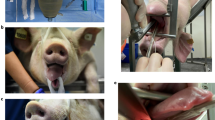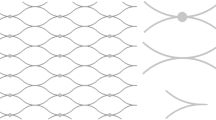Abstract
Vascular catheterization is increasingly carried out in laboratory mice, but the long-term patency of catheters implanted in mice is limited owing to their small size. The authors compared mice that were catheterized in their right common carotid artery either with a silicone catheter with a polyurethane tip or with a 100% polyurethane catheter to determine which catheter type was better suited for long-term studies in mice. The catheters were inspected daily and were flushed if blood was visible in the catheters; if no blood was visible, they were flushed every 3 d. Silicone catheters were patent for a shorter period of time than polyurethane catheters, which were patent for a median of 6 d and up to 25 d. The authors identify the principal causes of catheter failure and discuss how they can be prevented.
This is a preview of subscription content, access via your institution
Access options
Subscribe to this journal
We are sorry, but there is no personal subscription option available for your country.
Buy this article
- Purchase on Springer Link
- Instant access to full article PDF
Prices may be subject to local taxes which are calculated during checkout



Similar content being viewed by others
References
Sherertz, R.J., Carruth, W.A., Hampton, A.A., Byron, M.P. & Solomon, D.D. Efficacy of antibiotic-coated catheters in preventing subcutaneous Staphylococcus aureus infection in rabbits. J. Infect. Dis. 167, 98–106 (1993).
Siswanto, H., Hau, J., Carlsson, H.E., Goldkuhl, R. & Abelson, K.S. Corticosterone concentrations in blood and excretion in faeces after ACTH administration in male Sprague-Dawley rats. In Vivo 22, 435–440 (2008).
Christison, G.I. & Curtin, T.M. A simple venous catheter for sequential blood sampling from unrestrained pigs. Lab. Anim. Care 19, 259–262 (1969).
Spurlock, S.L., Spurlock, G.H., Parker, G. & Ward, M.V. Long-term jugular vein catheterization in horses. J. Am. Vet. Med. Assoc. 196, 425–430 (1990).
Swindle, M.M. et al. Vascular access port (VAP) usage in large animal species. Contemp. Top. Lab. Anim. Sci. 44, 7–17 (2005).
Grouzmann, E. et al. Blood sampling methodology is crucial for precise measurement of plasma catecholamines concentrations in mice. Pflügers Arch. 447, 254–258 (2003).
Balcombe, J.P., Barnard, N.D. & Sandusky, C. Laboratory routines cause animal stress. Contemp. Top. Lab. Anim. Sci. 43, 42–51 (2004).
Commission of the European Communities. Report from the Commission to the Council and the European Parliament: Sixth Report on the Statistics on the Number of Animal Used for Experimental and other Scientific Purposes in the Member States of the European Union SEC (2012) 1107 (The European Commission, Brussels, Belgium, 2010).
Yoburn, B.C., Morales, R. & Inturrisi, C.E. Chronic vascular catheterization in the rat: comparison of three techniques. Physiol. Behav. 33, 89–94 (1984).
Royo, F., Björk, N., Carlsson, H.E., Mayo, S. & Hau, J. Impact of chronic catheterization and automated blood sampling (Accusampler) on serum corticosterone and fecal immunoreactive corticosterone metabolites and immunoglobulin A in male rats. J. Endocrinol. 180, 145–153 (2004).
Abelson, K.S., Adem, B., Royo, F., Carlsson, H.E. & Hau, J. High plasma corticosterone levels persist during frequent automatic blood sampling in rats. In Vivo 19, 815–819 (2005).
Taketoh, J., Komatsu, S., Adachi, K., Takai, R. & Asanuma, K. Application of an indwelling vascular access port for intravenous administration in a repeated and intermittent dose toxicity study in rats. J. Toxicol. Sci. 34, 39–52 (2009).
Luo, Y.S. et al. Comparison of catheter lock solutions in rats. 51st Annual Meeting of the American Association for Laboratory Animal Science, San Diego, CA, 6 November 2000.
Nolan, T.E. & Klein, H.J. Methods in vascular infusion biotechnology in research with rodents. ILAR J. 43, 175–182 (2002).
Bardelmeijer, H.A. et al. Cannulation of the jugular vein in mice: a method for serial withdrawal of blood samples. Lab. Anim. 37, 181–187 (2003).
Sundbom, R., Jacobsen, K.R., Kalliokoski, O., Hau, J. & Abelson, K.S.P. Postoperative corticosterone levels in plasma and feces of mice subjected to permanent catheterization and automated blood sampling. In Vivo 25, 335–342 (2011).
Curelaru, I. et al. Material thrombogenicity in central venous catheterization III. A comparison between soft polyvinylchloride and soft polyurethane elastomer, long, antebrachial catheters. Acta Anaesthesiol. Scand. 28, 204–208 (1984).
Tan, R.H., Dart, A.J. & Dowling, B.A. Catheters: a review of the selection, utilisation and complications of catheters for peripheral venous access. Aust. Vet. J. 81, 136–139 (2003).
Colas, A. & Curtis, J. in Biomaterials Science: An Introduction to Materials in Medicine 2nd edn. (eds. Ratner, B.D., Hoffman, A.S., Schoen, F.J. & Lemons, J.E.) 80–86 (Academic, Boston, 2004).
Colas, A. & Curtis, J. in Biomaterials Science: An Introduction to Materials in Medicine 2nd edn. (eds. Ratner, B.D., Hoffman, A.S., Schoen, F.J. & Lemons, J.E.) 698–707 (Academic, Boston, 2004).
Institute for Laboratory Animal Research. Guide for the Care and Use of Laboratory Animals 8th edn. (National Academies Press, Washington, DC, 2011).
Jacobsen, K.R., Kalliokoski, O., Hau, J. & Abelson, K.S.P. Voluntary ingestion of buprenorphine in mice. Anim. Welfare 20, 591–596 (2011).
Abelson, K.S., Jacobsen, K.R., Sundbom, R., Kalliokoski, O. & Hau, J. Voluntary ingestion of nut paste for administration of buprenorphine in rats and mice. Lab. Anim. 46, 349–351 (2012).
Teilmann, A.C. The effect of automated blood sampling on corticosterone levels, body weight and daily food intake in permanently catheterized male BALB/c mice. In Vivo 26, 577–582 (2012).
Hurst, J.L. & West, R.S. Taming anxiety in laboratory mice. Nat. Methods 7, 825–826 (2010).
Fonseca, U.N., Nielsen, S.G., Hau, J. & Hansen, A.K. Permanent catheterization of the carotid artery induces kidney infection and inflammation in the rat. Lab. Anim. 44, 46–53 (2010).
Diehl, K.H. et al. A good practice guide to the administration of substances and removal of blood, including routes and volumes. J. Appl. Toxicol. 21, 15–23 (2001).
Crow, J.P., Calingasan, N.Y., Chen, J., Hill, J.L. & Beal, M.F. Manganese porphyrin given at symptom onset markedly extends survival of ALS mice. Ann. Neurol. 58, 258–265 (2005).
Fujii, M. et al. Strain-related differences in susceptibility to transient forebrain ischemia in SV-129 and C57black/6 mice. Stroke 28, 1805–1810 (1997).
Whitta, R.K., Hall, K.F., Bennetts, T.M., Welman, L. & Rawlins, P. Comparison of normal or heparinised saline flushing on function of arterial lines. Crit. Care Resusc. 8, 205–208 (2006).
EEC. Directive 2010/63/EU of the European Parliament and of the Council of 22 September 2010 on the protection of animals used for scientific purposes. Official Journal of the European Union L276, 33–79 (2010).
Acknowledgements
We thank Otto Kalliokoski for thoroughly reading and commenting on the manuscript.
Author information
Authors and Affiliations
Corresponding author
Ethics declarations
Competing interests
The authors declare no competing financial interests.
Rights and permissions
About this article
Cite this article
Teilmann, A., Falkenberg, M., Hau, J. et al. Comparison of silicone and polyurethane catheters for the catheterization of small vessels in mice. Lab Anim 43, 397–403 (2014). https://doi.org/10.1038/laban.570
Received:
Accepted:
Published:
Issue Date:
DOI: https://doi.org/10.1038/laban.570



